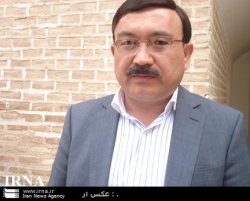ID :
239231
Tue, 05/08/2012 - 12:29
Auther :
Shortlink :
https://www.oananews.org//node/239231
The shortlink copeid
East Axis Transit Route Development Will Promote Regional Trade: Min.

Birjand, May 8, IRNA – Development of Iran’s East Axis Transit Route promotes regional trade, Afghanistan Minister of Transport and Civil Aviation Davood Ali Najafi said here on Monday.
Najafi made the remarks in an exclusive interview with IRNA.
The official pointed to his presence in the International conference of “South Khorasan, Transit and Development of East Axis', adding that it could help the resolution of regional problems and the boost of transit routes among neighboring countries.
“East Axis Transit Route is part of historical Silk transit route; Afghanistan can connect Iran to the central and south Asia.”
“There is a high level of trade relations between Iran and Afghanistan and Kabul is committed to expand the cooperation.”
An international conference dubbed “South Khorasan, Transit and Development of East Axis' has kicked off in the eastern Iranian city of Birjand on May 7.
The opening ceremony on Monday was attended by Iranian First Vice President Mohammad Reza Rahimi, Iran’s Minister of Road and Transportation Ali Nikzad and a group of state officials.
In addition to Iranian officials, transportation ministers from regional countries as well as Iran's ambassadors to Southeast and Central Asian nations are present at the event.
The most prominent foreign guests of the conference include transportation ministers of Afghanistan, Pakistan, Turkey, Oman, India and Central Asian states.
Ambassadors of Iran's neighboring countries as well as those of the Central Asian states, China, India and Oman are also participating in the conference.
Land transportation infrastructures, international trade corridors, special and free economic zones, maritime and air transportation, as well as trade and exports in the East were the major topics at the event.
East Axis is a transit route which starts from Iran's southern port city of Chabahar and reaches Central Asia after running through the Iranian cities of Zahedan, Birjand, Torbat Heidariyeh, and Mashhad. It is the sole transportation corridor connecting Central Asia and Afghanistan to free waters.
Afghanistan and Iran share an extensive history. Afghan-Iranian relations have improved since the fall of the Taliban and Iran has played an active role in Afghanistan’s reconstruction.
Afghanistan shares a long and intertwined history with Iran. There are also deep ties in language, its people and culture. As an eastern dialect of Persian, Dari is the dominant language in
Iran had supported the cause of the Afghan resistance against the Soviet occupation. Iran is also strongly against the American military presence in Afghanistan.
According to the United Nations High Commissioner for Refugees (UNHCR), about 1 million Afghan refugees live in Iran.
Since late 2001, the new Afghan government under Hamid Karzai has engaged in cordial relations with Iran. Afghanistan has an embassy in Tehran and a consulate in Mashad.
Trade between the two nations has increased dramatically since the overthrow of the Taliban in 2001. Iran and Afghanistan plan on building a new rail line connecting Mashhad to Herat and eventually to Kabul. In 2009 Iran was the fourth largest investor in Afghanistan, which is mainly in the construction of roads and bridges as well as agriculture and health care.
Iran exports oil products, cement, construction material, carpets, home appliances, and detergents and imports nuts, carpets, agricultural products as well as handicrafts from Afghanistan. Afghanistan imports 90 percent of its needs, except agricultural products./end





